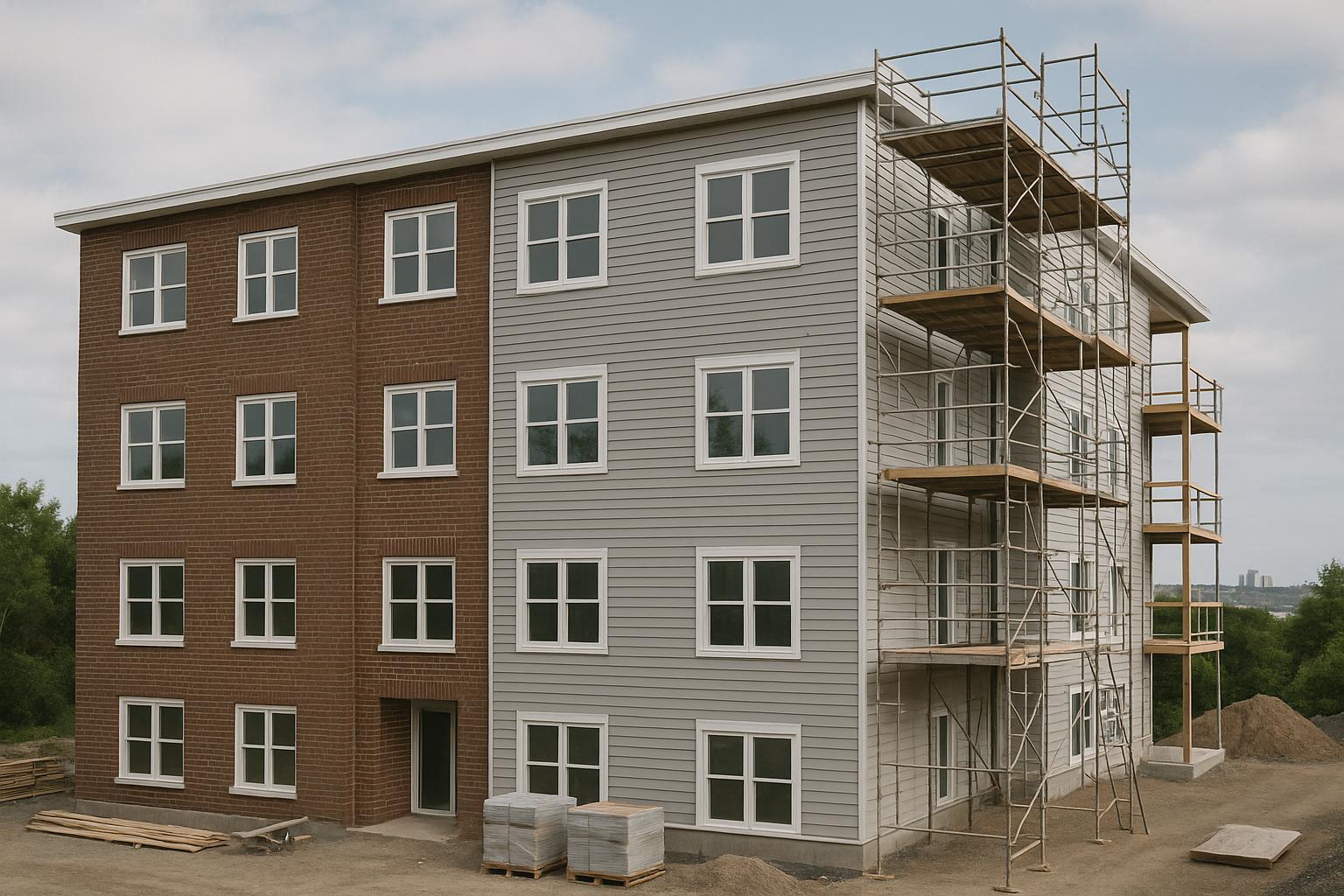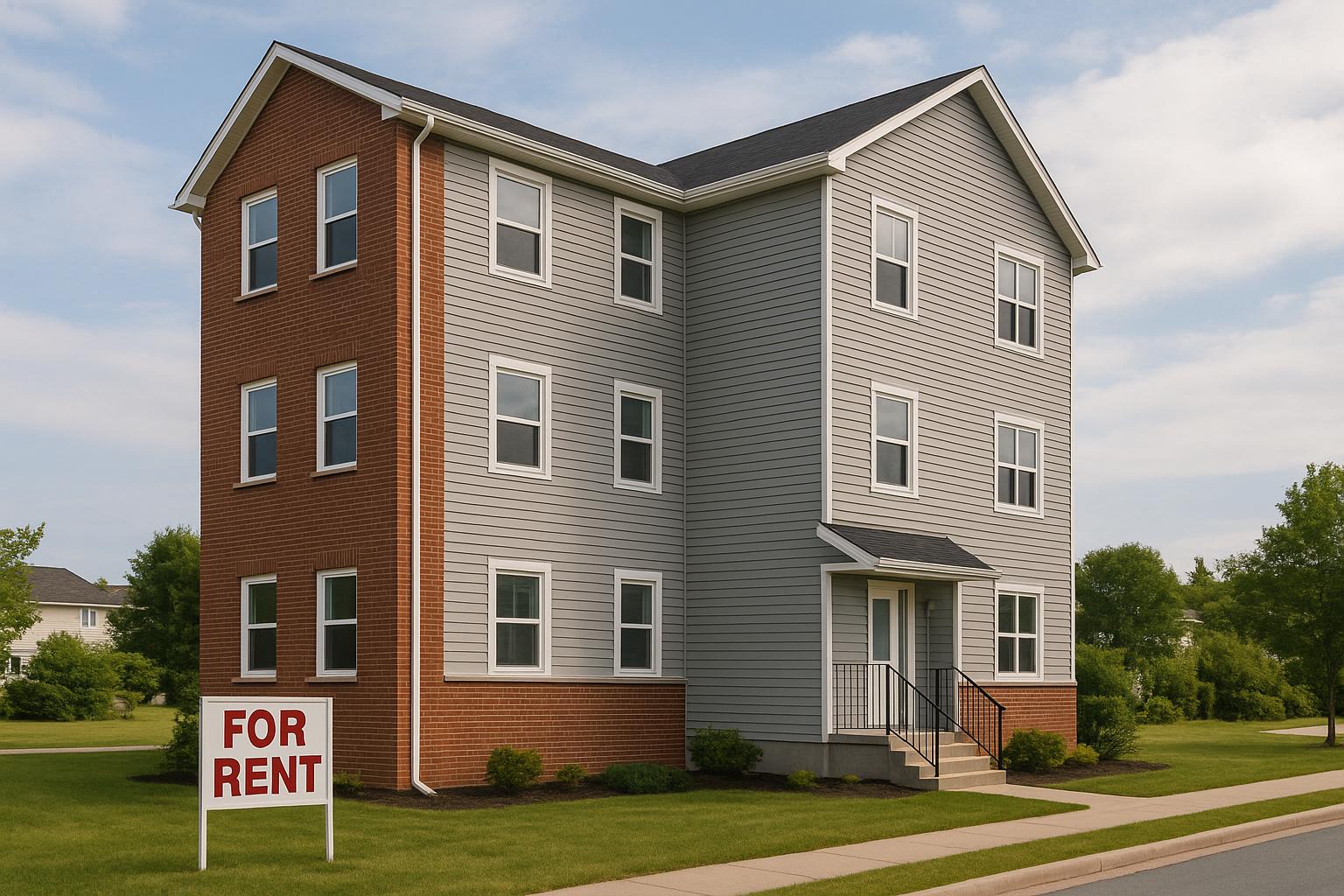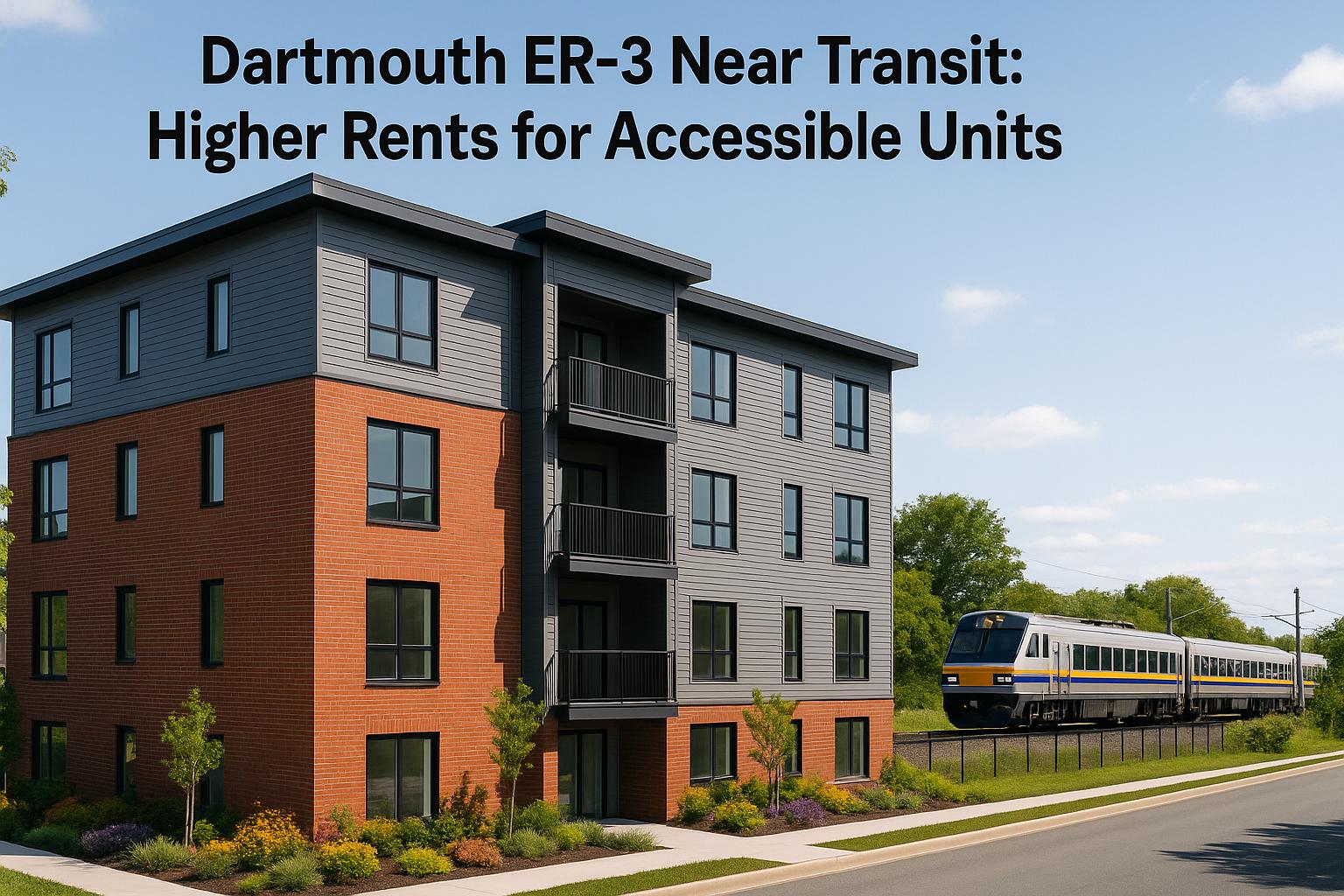Dartmouth is becoming a hotspot for apartment infill projects, thanks to Halifax's new Housing Accelerator Fund (HAF) reforms. These changes make it easier to build multi-unit properties, offering new opportunities for property owners and investors. Key takeaways from the article include:
- Neighbourhoods to Focus On: Downtown Dartmouth, Russell Lake, Dartmouth Cove, Woodside, and Crichton Park are highlighted as ideal locations for infill projects, each catering to specific renter demographics like young professionals and families.
- Rental Market Insights: Average rents for two-bedroom units range from $1,950 to $2,100/month, with low vacancy rates below 3%. Downtown Dartmouth commands higher rents due to transit access and amenities.
- Construction Costs: Costs per unit are $160,000–$200,000, depending on features like energy efficiency. Financing programs like CMHC MLI Select offer up to 95% financing and 50-year amortizations, making projects more accessible.
- Building Methods: Integrated design-build construction is recommended to avoid delays and cost overruns. This approach ensures better coordination, fixed costs, and faster completion times.
For investors, Dartmouth offers strong rental demand, competitive construction costs, and attractive financing options, making it a promising market for infill development.
Dartmouth development project to be extensive
What Makes Apartment Infill Succeed in Dartmouth
The success of apartment infill projects in Dartmouth largely depends on understanding the needs and preferences of local renters.
Who Rents and What They Want
Across Canada, Millennials make up the largest group of renters, with a median age of 39 and a median income of $42,500 [1]. Single-person households dominate, accounting for 38.1% of renters, while married couples and other arrangements make up 26.1% and 24.3%, respectively [1]. When choosing a rental property, renters focus on key factors like affordability, location, safety, and access to essential amenities [2][3].
With average rents sitting at $2,471, the demand for reasonably priced, conveniently located properties is stronger than ever. Renters are particularly drawn to one- and two-bedroom units that meet these criteria. This demand highlights the importance of carefully selecting Dartmouth neighbourhoods that are well-suited for apartment infill projects.
Best Dartmouth Neighbourhoods for Apartment Infill
These Dartmouth neighbourhoods are perfect for apartment infill projects, offering strong rental demand and stable income potential. Local tenant demographics and market trends highlight why these areas are ideal for development [5].
Downtown Dartmouth
Downtown Dartmouth stands out for its walkability and excellent transit options. It's especially popular with young professionals thanks to its easy access to the Halifax Transit ferry and a variety of local amenities. These features allow landlords to charge premium rents [5].
Russell Lake Area
The Russell Lake area is a favourite among families, thanks to its well-regarded schools and a mix of suburban comfort with urban convenience. Offering two- and three-bedroom units here caters to long-term renters looking for space and stability [4][5].
Dartmouth Cove
Dartmouth Cove is an attractive option for young professionals, drawn by its waterfront views and growing commercial hubs. Highlighting the area's outdoor lifestyle and nearby amenities can make properties here even more appealing to renters [5].
Woodside
Woodside enjoys steady rental demand due to its proximity to key employers like Dartmouth General Hospital and NSCC. This makes it a reliable choice for attracting healthcare workers and students [4][5].
Crichton Park
Crichton Park is known for its quiet streets and access to top-tier schools, making it a prime neighbourhood for families. Designing units with families in mind can help secure long-term tenants in this area [5].
sbb-itb-16b8a48
How to Avoid Construction Problems with Better Methods
In Dartmouth, the construction method you select can make or break your project's success and directly impact your monthly rental income. The right approach can mean collecting rent on time, while the wrong one might lead to frustrating delays.
Fragmented vs. Integrated Construction Methods
Traditional fragmented construction requires property owners to juggle multiple professionals - architects, engineers, general contractors, and subcontractors - who often work independently. This lack of coordination frequently leads to finger-pointing when problems arise, leaving property owners stuck trying to resolve conflicts.
In Nova Scotia, this approach is notorious for budget overruns ranging from 30% to 60% and timeline delays that can stretch an 8-month project into a gruelling 18-month ordeal. For property owners, these delays can mean losing out on approximately $8,800 in monthly rental income.
On the other hand, integrated design-build construction brings all aspects of a project - planning, architecture, engineering, and construction - under one unified team. This approach eliminates the blame game because everyone involved shares accountability and works toward the same goal. In Dartmouth, this method has proven to deliver projects on time and within budget, meeting the demand for efficient and cost-effective construction.
A prime example of this approach in Nova Scotia is a leading design-build firm currently managing 31 units across the province. They’ve achieved a flawless track record - no cost overruns and no timeline delays - by ensuring all professionals work in sync.
The financial benefits are clear. Property owners using integrated methods save an average of $47,000 in coordination-related inefficiencies compared to fragmented approaches.
Another key advantage of integrated construction is fixed-price contracts. These contracts provide property owners with a guaranteed construction cost - $160,000 per unit in many cases - before the project even begins. Plus, builders face penalties of up to $1,000 per day if they miss deadlines, offering an added layer of protection for owners.
Real Project Examples
In Dartmouth, the advantages of integrated construction are evident in local success stories. Property owners who choose this method consistently hit their budget and timeline targets, while those relying on fragmented approaches often encounter predictable setbacks.
Integrated builders maintain high-quality standards through regular inspections by professional engineers (P.Eng) and daily progress updates with photos. This ensures there are no communication gaps, and property owners can track their project's progress in real time - an impossible feat when coordinating multiple independent contractors.
The scheduling benefits are especially critical in Dartmouth's competitive rental market. Integrated builders use advanced coordination systems to prevent delays caused by misaligned trades, enabling property owners to confidently market their units with a clear timeline for tenant readiness.
Local expertise also plays a major role. Integrated builders familiar with the Halifax region understand local permitting processes, inspection requirements, and supplier networks. This knowledge helps avoid unexpected delays that often arise when working with contractors unfamiliar with the area.
Additionally, integrated construction opens doors to financing opportunities. For instance, property owners can access programs like CMHC MLI Select, which offers 95% financing with a 50-year amortization. These programs often require meeting energy efficiency standards, which integrated teams are well-equipped to handle. In contrast, fragmented methods make achieving compliance far more uncertain.
For property owners building in Dartmouth’s prime locations - Downtown, Russell Lake, Dartmouth Cove, Woodside, and Crichton Park - construction delays and cost overruns can devastate returns. Integrated construction methods provide the reliability and efficiency needed to succeed in these highly competitive markets.
Rents, Construction Costs, and Returns in Dartmouth
Dartmouth continues to draw attention for apartment infill projects, thanks to its strong financial appeal.
Rental Income and Vacancy Rates
Rental prices for 2-bedroom apartments in Dartmouth typically range from $1,950 to $2,100 per month, with the higher end found in Downtown Dartmouth. This area commands premium rents due to its access to transit and local amenities. Vacancy rates remain low - below 3% - highlighting a stable and reliable rental market.
This demand is driven by young professionals, many of whom work in nearby Halifax. Dartmouth offers them a more affordable lifestyle and shorter commutes, making it an attractive alternative.
Construction Costs and Financing
Building costs in Dartmouth vary between $160,000 and $200,000 per unit. The lower end of this range includes energy-efficient features, while the CMHC MLI Select program pushes costs closer to $200,000 per unit. This program allows for up to 95% financing with a 50-year amortization, making it a popular choice for developers.
For traditional construction financing, developers typically need a larger down payment - about 20%. However, the CMHC MLI Select option significantly lowers this requirement, sometimes needing as little as 5% down. Many developers also opt to invest an additional $15,000 per unit in a Premium Rental Ready Package. This package speeds up the process of getting units ready for tenants, minimizing delays.
These cost structures and financing options make Dartmouth projects particularly appealing for investors.
Return Projections and Long-Term Benefits
Dartmouth's competitive construction costs and favourable financing terms translate into solid returns. Investors often aim for annual returns between 8% and 12%, supported by efficient financing and high-quality construction.
Energy-efficient upgrades offer dual benefits: they lower utility costs for tenants and allow property owners to charge slightly higher rents. This combination strengthens the potential for steady, long-term returns.
Looking ahead, demographic shifts and zoning changes are expected to keep demand for rental housing high. Investors in well-designed infill projects can enjoy reliable rental income while also benefiting from potential property appreciation.
For projects with four or more units, initial investment costs start at approximately $640,000 for standard builds and $800,000 for CMHC MLI Select developments. These numbers underscore the financial promise of Dartmouth’s infill opportunities, making it a compelling option for property developers and investors alike.
Getting the Most from Dartmouth's Infill Market
Navigating Dartmouth's apartment infill market successfully comes down to three main decisions: choosing the ideal location, understanding what tenants want, and working with skilled construction professionals to avoid common building issues.
Properties located near transit and amenities tend to attract tenants willing to pay higher rents. These renters often look for modern conveniences like energy-efficient appliances, in-suite laundry, and reliable internet connectivity. Meeting these expectations makes streamlined construction methods even more crucial.
One effective approach is integrated construction, which simplifies coordination by consolidating all professionals under a single contract. A Nova Scotia-based design-build firm exemplifies this model. With 31 units currently under construction, they offer a fixed-price structure of $160,000 per unit and guarantee completion within six months. To ensure accountability, delays can result in financial penalties of up to $1,000 per day.
Smart financing is another essential piece of the puzzle. Tailored financing terms can enhance cash flow, especially when paired with programs that extend amortization periods or reduce down payment requirements.
For property owners looking to hit the ground running, the Premium Rental Ready Package is an appealing option. For an additional $15,000 per unit, this package includes Energy Star appliances, smart home technology, and window coverings. This allows owners to start collecting rent immediately, skipping the typical furnishing delays.
As demand grows and construction innovations advance, entering the market at the right time is crucial. With 131 more units in the planning stages across Nova Scotia and steady regional growth, now is the time to secure experienced construction partners and prime infill locations. This proactive approach can give property owners a competitive advantage in an evolving market.
FAQs
What are the advantages of using integrated design-build methods for apartment infill projects in Dartmouth?
Integrated design-build methods offer notable benefits for apartment infill projects in Dartmouth. By merging design and construction into a single team, this approach simplifies the process, cutting down on delays and speeding up project completion.
Another key advantage is improved cost control. With better coordination and communication between team members, unexpected expenses are less likely to arise. This teamwork-driven approach also encourages accountability, leading to better-quality outcomes and smarter use of resources. For property owners, this translates to fewer hassles, faster returns on investment, and a much smoother project experience.
How do Halifax’s Housing Accelerator Fund reforms affect the potential and profitability of infill projects in Dartmouth?
The recent updates to Halifax's Housing Accelerator Fund (HAF) have introduced a game-changer for property development in the region. These reforms now permit up to four-unit buildings by default across Halifax, including Dartmouth. By cutting through red tape and streamlining approval processes, the changes make it easier to pursue infill projects and boost housing density. This, in turn, can enhance rental income potential and improve the overall feasibility of such developments.
For property owners in Dartmouth, this translates to a more straightforward path for launching multi-unit projects. With rental demand on the rise in the area, these updates offer a chance to increase profits while also addressing the community's housing needs.
What should investors look for when selecting a neighbourhood in Dartmouth for apartment infill projects?
When selecting a neighbourhood in Dartmouth for apartment infill development, it’s crucial to pay attention to zoning regulations that allow for higher-density housing. Areas recently approved for 4–8 unit buildings are especially worth considering, as these policies can directly influence the viability and profitability of your project.
You’ll also want to look at the proximity to amenities like public transit, schools, and shopping centres, as well as the availability of essential infrastructure and utilities. Neighbourhoods with strong tenant demand and well-thought-out community planning tend to offer better opportunities for steady rental income and long-term growth.
Taking the time to delve into local planning strategies and neighbourhood plans can help you pinpoint areas with favourable conditions for multi-unit development. This approach ensures your project aligns with current market needs and municipal guidelines, helping to minimise risks while boosting your potential returns.



